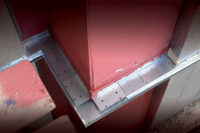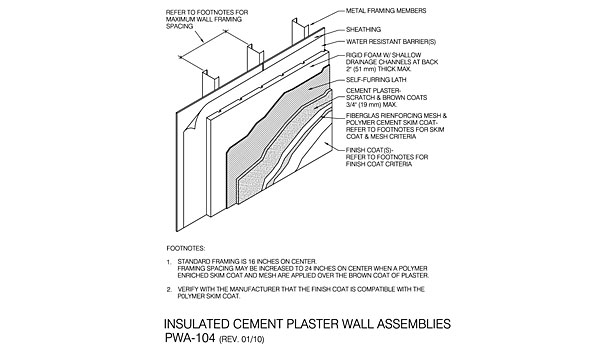stucco Stop
Continuous Insulation and Plaster Assemblies






Energy code regulations are requiring a more prevalent use of continuous insulation. CI designs are intended to prevent or minimize thermal transference (also known as thermal bridging). In our plastering industry, thermal bridging is related to the natural thermal conductivity of steel used in light gauge framing and directly affects our current energy usage levels. Wood framing can also be attributed to thermal bridging but to a lesser degree than steel. The plastering industry has always been proactive with energy issues and has for many years been applying stucco over foam boards. This month we’ll look at some three coat stucco assemblies over CI.
If you read my last column (“EIFS: A Solution for New Energy Efficiency Requirements,” W&C May 2013) you’ll remember that I pointed out that EIFS meets the definition of a true continuous insulation cladding and was the first kid on the block that offered a continuous insulation “system,” as an exterior cladding. EIFS is a first consideration for designers and contractors to comply with the new energy codes. Stucco over CI also performs very well and really only loses minimal amounts of energy via transference (thermal bridging) from the fasteners and in some assemblies, the trims.
Back in my plastering days, we did a fair amount of stucco over foam. We had to have custom trims bent to make our weep screeds and casing beads for the three-coat assemblies. The control joints were affixed to the wire lath on the surface of the foam and we had to pay close attention to the fasteners to make sure they nested properly. It took a little longer than a conventional stucco assembly but after a short learning curve, it became second nature. Back in those days, there weren’t a lot of three-coat over foam assemblies; mostly we did one-coat over foam and it was on residential structures. Never the less, stucco has been applied over foam successfully for many years.
STUCCO ASSEMBLIES
A few years ago, The Western Conference of the Wall and Ceiling Institutes created a brochure to illustrate EIFS, one-coat stucco and three-coat stucco assemblies. The three-coat assemblies are those that are common, time proven and compliant to the new energy codes. The Western Conference is made up of industry technical experts from the Technical Services Information Bureau, the Northwest Wall and Ceiling Bureau, and the Wall and Ceiling Alliance who, based on their combined experiences, collaborated to illustrate these assemblies.
The three-coat stucco assemblies illustrated represent the most commonly used and are only representative of the plastering industry. The assemblies are called PWA 104 (CI under cement plaster), PWA 105 (CI over cement plaster) and PWA 106 (exterior insulation with Z channels). The brochure also contains calculation tables that provide guidelines for selection of foam board thickness and cavity insulation R-values used to achieve the desires thermal resistance for a given wall assembly.
PWA 104
This is the assembly I applied back in the day (Figure 1). It is the most straightforward assembly and is basically a conventional three-coat stucco and finish, over sheathing with an insulation layer of foam placed between the water-resistive barrier and the three-coat stucco assembly. Placing the WRB between the sheathing and the foam is the proper location. In this location the WRB can be fastened flat to the sheathing and won’t become torn, like it would if it were on top of the foam, when fasteners go through it. As with any exterior cladding that has foam, all of the foam insulation must be completely encapsulated by either a metal trim, or a stucco layer. The stucco assembly is applied over the foam in compliance with ASTM C-926. With this PWA assembly, it is recommended that a lamina layer (polymer enhanced cement and mesh) be applied over the brown coat to minimize cracking. Cement or acrylic finish coats may be applied to this assembly. Ensure that the finish material is compatible with the lamina layer products.
PWA 105
This is not an EIF system. In this assembly the scratch and brown are applied like any other three-coat assembly, per ASTM C-926—and should be hydrated properly (Figure 2). There are exceptions though; you don’t need to float or finish the brown coat and it is not recommended to apply a lamina layer over the brown coat either. EPS foam board is then adhered to the brown coat, a 4- to 6-ounce fiberglass mesh is embedded into a coat of polymer enriched cement, and then an acrylic finish coat is applied. I would recommend that you use the components manufactured by an established EIFS manufacturer for the CI layer. This assembly is excellent for retrofit to existing structures that may be required to meet the newer energy code requirements.
PWA 106
This assembly utilizes a minimum 18 gauge “Z” furring member (maximum 2 inches depth) attached to a sheathed wall assembly along the framing members (Figure 3). Foam board is then placed between the Z members and a layer of sheathing is attached to the outer face of the Z members. The Z members can act as a thermal bridge in this assembly however, the gypsum panels on each side of the Z member act as a moderate thermal break. To complete the thermal break a minimum 3/16-inch thick foam tape shall be added to the outer face of the Z member. The three-coat stucco assembly is then applied to this assembly per ASTM C-926. In this assembly a lamina layer over the brown coat is recommended when framing is spaced 24 inches o.c.
Unlike the old days where we ordered special stucco accessories, there are new ones available for these assemblies that are very well thought out and were specifically designed for the thickness increase of a CI stucco assembly. AMICO makes innovative trim pieces and utilize the common screws-as-fasteners method to assemble a CI stucco cladding. Brand X Metals is a new company that makes specially configured trims and utilizes both screw fasteners and the time proven method of wire-tying. Both are innovative and readily available.
EASE THE MIND
OK, let’s address the 500-pound gorilla here: Won’t the weight of the three-coat stucco shear off the fasteners since the cladding is cantilevered off the framing members? Our logical minds paint a mental picture of a catastrophic occurrence; stucco falling off the building and crashing to the ground, right? Rest your mind, testing has already been done.
The Foam Sheathing Coalition published a technical document titled “Guide to Attaching Exterior Wall Coverings Through Foam Sheathing to Wood or Steel Framing.” The Tech Matters document gives a “step-by-step approach for the design process when assembling claddings over foam board insulation.” There are charts that guide one to component selection, fastener spacing and foam thickness maximums.
The criterion is irrespective of the type of cladding choice and all one needs to know is the weight of the cladding. (Note: these results didn’t even take into account that stucco adheres readily to foam sheathing, a plus.) So, working from the chart, and keeping in mind that three-coat stucco weighs approximately 10 to 12 pounds per square foot, let me give you an example: If a wall assembly uses 33 mil steel studs, 16 inches o.c. and the lath is attached every 6 inches vertically, with #8 screws to the framing members, then the maximum foam thickness could be 3 inches (4 inches if you use #10 screws and 43 mil steel).
Sustainable design is not a fad—it isn’t going to lose popularity and in fact, is the way we will be building into the future. The time and expense of building new power generating facilities is almost prohibitive. Our easiest path to stemming the demand is to reduce the demand through energy efficient design. Our codes are adopting more stringent thermal performance requirements and are increasingly becoming the force behind our sustainable design and application decisions. The continuous insulation cladding solutions specific to the plastering trades are time proven systems and assemblies. EIFS, a lightweight first choice true CI system, and stucco, a timeless classic assembly, both provide code compliant, insulating claddings, utilizing simple and familiar detailing.
Looking for a reprint of this article?
From high-res PDFs to custom plaques, order your copy today!











